|
Resicast
35168 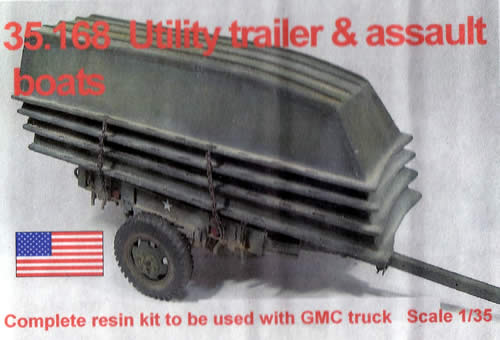
Resicast
is one of the most ambitious manufacturers when it comes to subject matter. This
is proven once again with the Utility Trailer and Assault Boats set. These smallish
boats were used to move combat soldiers across rivers and streams throughout France
and Germany, and were employed by engineers as they constructed bridges to span
those waters and rush AFVs and supplies to the front. 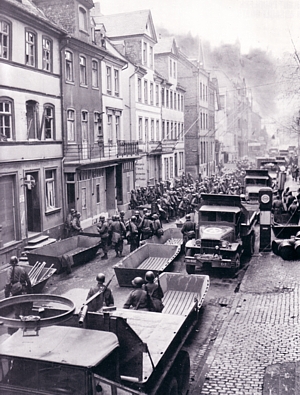 Not
falling into the "sexy tank" category, such boats and trailers don't
get any attention outside of engineer references, which are themselves difficult
to come by. There are some period photos of the boats in use, but I have yet to
see the trailer, either loaded or unloaded. The kit's instructions include a handful
of technical manual illustrations and museum photos, which help with the construction.
But you'll need to make some decisions on how you want to use this kit, whether
in a diorama setting or standing alone. Not
falling into the "sexy tank" category, such boats and trailers don't
get any attention outside of engineer references, which are themselves difficult
to come by. There are some period photos of the boats in use, but I have yet to
see the trailer, either loaded or unloaded. The kit's instructions include a handful
of technical manual illustrations and museum photos, which help with the construction.
But you'll need to make some decisions on how you want to use this kit, whether
in a diorama setting or standing alone.
I've
found Resicast's instruction sheets to be the weakest part of their kits. The
directions provided here are a marginal improvement, but still include some mistakes.
There is a step-by-step list of assembly instructions, which is helpful. However,
some parts are misidentified: photoetch parts 23 should be 22; both photoetch
parts 9 should be placed at the front of the trailer frame, and both parts labeled
as 10 should be positioned at the rear of the frame; identification of resin parts
2 and 3 are reversed. The photo illustrations of the construction process are
murky black and white images that can confuse as much as help. The instructions
indicate the wheels and spare should be glued in place fairly early in the assembly,
but you might want to leave them off to paint separately from the trailer.  The
kit comes with four boats. Two are molded separately, and the other two are molded
together. Personally, I would have preferred all boats being separate for more
versatility in a diorama setting. Of course, if you want to show all the boats
loaded on the trailer, this isn't an issue. The
kit comes with four boats. Two are molded separately, and the other two are molded
together. Personally, I would have preferred all boats being separate for more
versatility in a diorama setting. Of course, if you want to show all the boats
loaded on the trailer, this isn't an issue.
However,
there are questions about how the boats were stowed on the trailer that need answers
that the instructions don't provide. The trailer carried four "balk clamping
beams" that were chained to the side rails to hold down the load, as well
as a "longitudinal clamping beam" that presumably secured shorter objects.
What is not clear is whether the balk clamping beams were used to retain the boats—the
box art and museum photos in the instructions and a couple shots found on the
web show the boats simply secured with chains. Thanks to Kurt Laughlin, the answer
was found—or at least strongly suggested—in TM5-9074 Maintenance
Manual and Parts Catalogue for Trailer, Two-wheel, Utility, Pole Type, 2-1/2 Ton,
Type 1, Infantry Support Raft and/or Pneumatic Bridge Equipment, Model D-2424.
While not stating explicitly that the load is a set of boats (the trailers could
carry an assortment of equipment), the TM instructs: "Place the clamping
beams across the load at the front and back of the chassis. The binding chains
are used for holding the beams down on the load, thereby securing it to the chassis.
Turn the binding screw and raise the binding screw hook near the top. Attach the
loose end of the chains in the hooks on the ends of the beams, engaging them as
short as possible. Tighten securely with the binding screws, being careful to
tighten the screws evenly on both sides." The accompanying TM illustration
is the same as that in the instructions. So the TM at least strongly confirms
that the beams should be used with the boats, as opposed to what the museum photos
indicate. 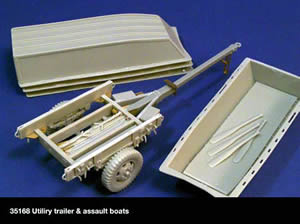 The
adjustable pole that connected the trailer to the truck also presents a question:
which of the three positions was correct for a load of boats? The TM provided
the answer: "Keep pole in fully telescoped or in first position out as much
as possible. Do not extend to completely extended position unless absolutely necessary." The
adjustable pole that connected the trailer to the truck also presents a question:
which of the three positions was correct for a load of boats? The TM provided
the answer: "Keep pole in fully telescoped or in first position out as much
as possible. Do not extend to completely extended position unless absolutely necessary."
We
come to take explicitly stated "alternatives" for granted in plastic
kits, when the directions indicate you can use one part or another. It's always
helpful to know the whys and wherefors, particularly with an obscure subject such
as this one.
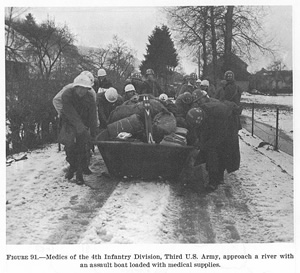 This
kit practically demands to be used in a small diorama. I have not yet completed
mine pending a final decision on the action of the scene. Much of the dilemma
revolves around finding just the right figures (remember the DML set with the
Germans carrying the rubber raft? Wouldn't it be nice if....). I'd also like to
do some more research and see if I can find additional period photos of the trailer
and boats in use. This
kit practically demands to be used in a small diorama. I have not yet completed
mine pending a final decision on the action of the scene. Much of the dilemma
revolves around finding just the right figures (remember the DML set with the
Germans carrying the rubber raft? Wouldn't it be nice if....). I'd also like to
do some more research and see if I can find additional period photos of the trailer
and boats in use.
Overall,
the kit is quite accurate when compared to the TM drawings. The most notable shortcut
is the missing pockets at the ends of the two main side frame pieces, into which
2"x4" boards could be set to help keep the load in place. The only accessories
included are 8 paddles, which is enough for one boat. Photos show the paddles
were usually carried in a canvas bag, likely one bag per boat. In some pictures
the paddles appear unpainted. 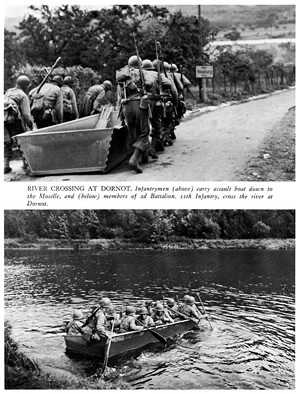 The
casting of the parts is generally quite clean and the parts are crisp and well
defined. Many are delicated an require extra care when removing them from the
carriers. The area that needs the most attention are the handholds in the outer
rims of the boats, which require some careful cleaning (notice in the photo of
the boats in the street that one of the handholds has broken off from the rim
of the boat on the right). Resicast's photoetch is very well done, and the two
frets in this kit, one for trailer hardware and the other holding two sizes of
chains, is no exception. There are no painting instructions or decals provided.
Olive drab is the obvious paint choice. The TM says a registration number was
painted on the "rear bolster," the cross-wise piece perpendicular to
the two sides. The
casting of the parts is generally quite clean and the parts are crisp and well
defined. Many are delicated an require extra care when removing them from the
carriers. The area that needs the most attention are the handholds in the outer
rims of the boats, which require some careful cleaning (notice in the photo of
the boats in the street that one of the handholds has broken off from the rim
of the boat on the right). Resicast's photoetch is very well done, and the two
frets in this kit, one for trailer hardware and the other holding two sizes of
chains, is no exception. There are no painting instructions or decals provided.
Olive drab is the obvious paint choice. The TM says a registration number was
painted on the "rear bolster," the cross-wise piece perpendicular to
the two sides.
Once
again, Resicast has gone where no other companies have dared to go, and produced
a unique American subject that should spark interest in those modelers who are
looking for an alternative to the plentiful Shermans and half-tracks we're enjoying. Thanks
to Graham Sellars for the review sample and Kurt Laughlin and Mike Powell for
their help in finding reference materials. -tss | 











